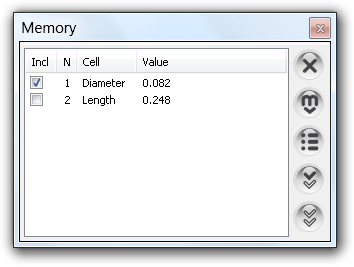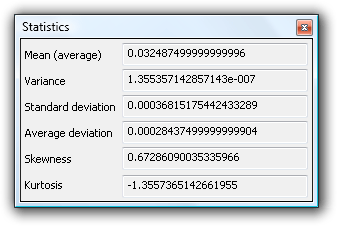| LIBROW |
| Professional | Help | Support | Contacts |
Help 1.4
How to calculate data statistics
1. Workflow
Calculating data statistics is straightforward: put dataset into calculator memory and click Statistics.
 Fig. 1. Statistics is the middle button in Memory window.
Fig. 1. Statistics is the middle button in Memory window.
Statistics button performs calculation on selected values in Memory or on all values if there is no selection.
2. Statistic data
Clicking Statistics button brings in the Statistics window.
 Fig. 2. Statistics.
Fig. 2. Statistics.
Window shows the next values:
| Value | Description | |
|---|---|---|
| 1 | Mean (average) | The sum of elements divided by their number: x = ∑xn / N. |
| 2 | Variance | Var(x1, ... , xN) = ∑(xn − x)2 / (N − 1). |
| 3 | Standard deviation | Square root of Variance: σ(x1, ... , xN) = √Var. |
| 4 | Average deviation | Or mean absolute deviation: ADev(x1, ... , xN) = ∑|xn − x| / N. |
| 5 | Skewness | Or third moment: Skew(x1, ... , xN) = ∑[(xn − x) / σ]3 / N. |
| 6 | Kurtosis | Or fourth moment: Kurt(x1, ... , xN) = ∑[(xn − x) / σ]4 / N − 3. |
3. Example
Let us have {a1, a2, a3, a4} data set, put it into calculator memory:
2.1−>mem[a1];
2.3−>mem[a2];
2.4−>mem[a3];
3.3−>mem[a4];Fire Ctrl+Shift+= to put the values into memory. Now, click Statistics button in the Memory window to perform calculations — Statistics window is displayed with results.
Now, suppose, we want to exclude a4 value from our data set. Click Invert selection button in the Memory window — all values get selected — and uncheck the a4 value. Click Statistics button again to recalculate statistics this time for truncated set {a1, a2, a3}.
| Chapter 1 Getting started |
|
| Chapter 2 How to calculate |
|
| Chapter 3 How to use memory |
|
| Chapter 4 How to calculate data statistics |
|
| Chapter 5 How to print out calculations |
|
| Chapter 6 How to customize the interface |
|
| Chapter 7 Keyboard shortcuts |
|
|||||||||||||
|
|||||||||||||